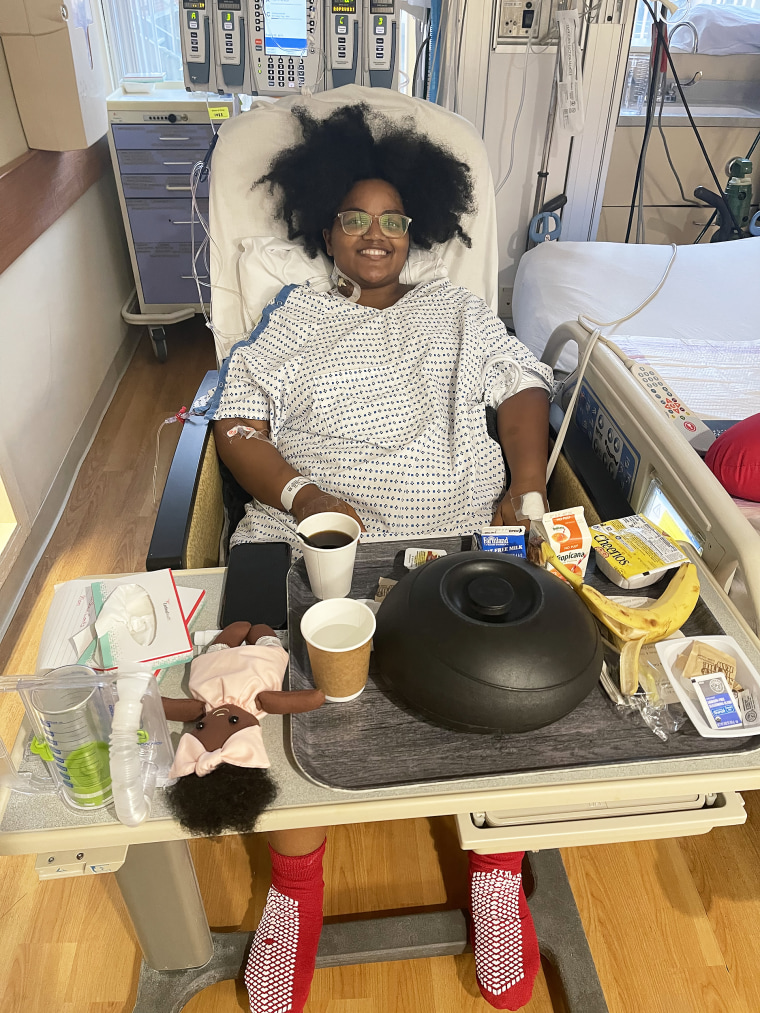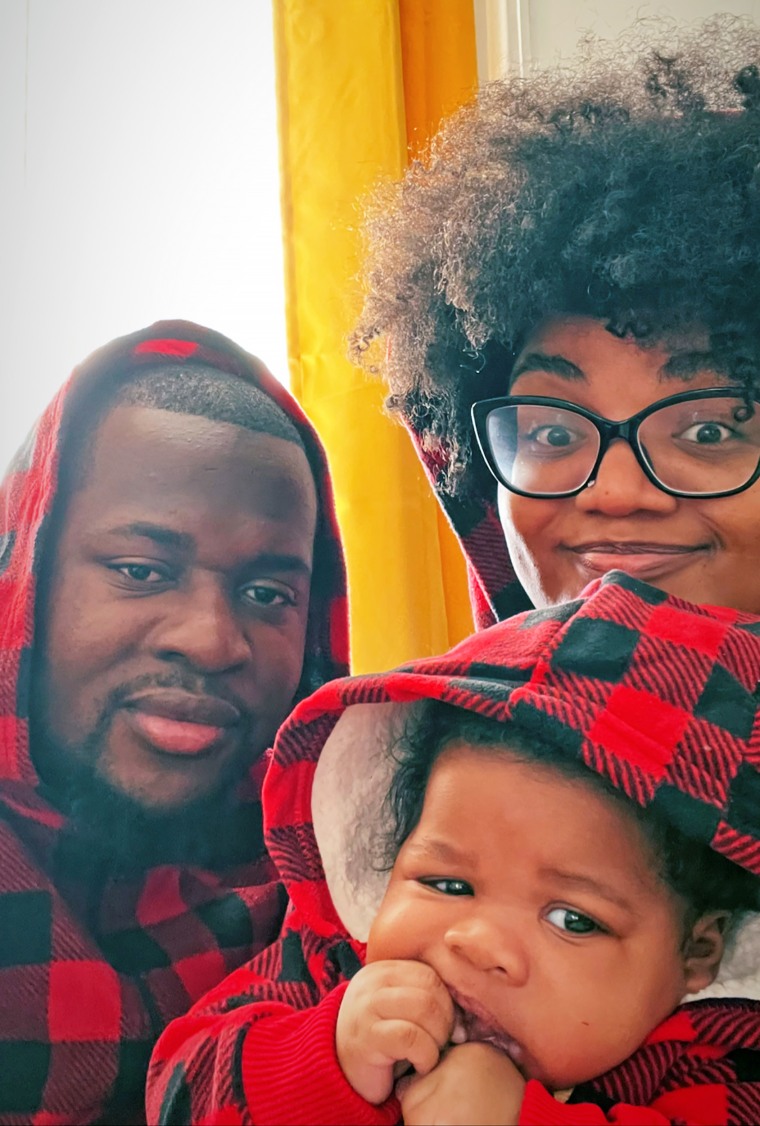A week after giving birth to her new baby girl in early September, Antiganee Cain-Francis, 32, and her husband were adjusting well to their new life.
Cain-Francis was recovering from her C-section and working on breastfeeding. "Everything was great that week — as great as it could be with a newborn," she tells TODAY.com. "We were just getting used to our routine and her habits."
But that weekend, everything "started to shift," says Cain-Francis, a public school teacher in New York City.
All Cain-Francis remembers is relaxing while watching "Love Is Blind: Brazil" before getting up to check on her daughter, Aella. Then, suddenly, she noticed a "static feeling" and wasn't able to see or hear.
While she doesn't remember what happened after that, her husband, Shaquelle, later told her that he heard her screaming his name. He called her OB-GYN, who urged them to go to the emergency room.
The event set off about three weeks of hospital stays and medical detective work to find — and finally treat — the exceedingly rare cause of Cain-Francis' life-threatening symptoms.

Looking for answers
Cain-Francis was taken to Lennox Hill Hospital and stabilized. But the next day, at around 2:30 a.m., she had another episode and went into cardiac arrest.
The medical team was able to resuscitate her and Dr. Sirish Vullaganti, director of heart failure at Lenox Hill Hospital, decided to put her on a ventilator and extracorporeal membrane oxygenation (ECMO), a machine that supports the heart and lungs and ensures the patient gets enough oxygenated blood.
Once stabilized again, Vullaganti transferred Cain-Francis was to North Shore University Hospital on Long Island. There, she met with electrophysiology specialist Dr. Ramanak Mitra.
After three days on ECMO, Cain-Francis' heart rhythm was "completely normal," Mitra tells TODAY.com. So, at that point, the team made the decision to start her on some medications and remove the ventilator so that they could communicate with her.
"She seemed to be doing well," Mitra says, "but within about 24 hours, she started to have a few of these extra beats." During an EKG procedure to try to map out the abnormal beats, "she again went into rapid, sustained arrhythmia," he says. She went into cardiac arrest again and was resuscitated for the second time.
But the team was able to capture the beats on their monitoring system, which gave Mitra more clues about what might be going on.

Cain-Francis had no warning signs before her first episode, no family history of heart disease or sudden death and no genetic markers to point doctors in a particular direction. The team at Lennox Hill Hospital had already ruled out a coronary artery dissection, a heart condition that's more common among younger women. They'd also ruled out peripartum cardiomyopathy, a type of muscle weakness in the heart that can arise around the time of delivery.
But when Mitra's team looked at the electrical tracings of her heart rhythm that was captured on the monitor, they noticed a similar pattern before every episode. That suggested Cain-Francis had a primary rhythm problem caused by an electrical issue within the heart.
The culprit: triggered ventricular fibrillation
The pattern of heartbeats Mitra saw before each of Cain-Francis' episodes led him to suspect that she had a type of arrhythmia called triggered ventricular fibrillation. In people with this condition, "there's one particular site in the heart muscle," he explains, "and when it fires, it basically puts the heart into a tailspin."
In Cain-Francis' case, the condition is idiopathic, meaning doctors don't know why it developed. That's especially rare in patients as young as Cain-Francis, Mitra says.
While experts don't know exactly what causes triggered ventricular fibrillation happens, the condition is thought to originate in the heart's Purkinje fibers, which are responsible for sending specialized electrical signals that control the heart's pumping muscles.
To treat the condition, Mitra needed to perform a procedure called catheter ablation. During this procedure, the part of the heart that's causing these irregular beats gets cauterized through a tiny catheter.
"The challenge there is that you have to be having these beats in order for us to know where to find them," Mitra says. “If they’re not having these beats and we can’t provoke them, then we don’t have any target of where to ablate."
Sometimes, if the patient is otherwise stable, doctors can stimulate the irregular beats and find them. But because Cain-Francis was still on ECMO, that wouldn't be possible for her. Instead, Mitra performed a procedure called pace mapping, which allowed him to replicate and pinpoint the source of Cain-Francis' abnormal heartbeats.
"After that, it's a matter of hope," Mitra says. "You've got a theory, but the only way to tell is just to wait and see."

"It's okay to need help — and to accept it."
One day after the ablation, Cain-Francis "passed with flying colors" and had no abnormal rhythms, Mitra says. After another day, she was taken off ECMO and put on some medication. (She also was able to get an MRI, which confirmed that she had no underlying structural issues or inflammation in her heart.)
It wasn’t until after the ablation procedure that Cain-Francis remembers waking up in the hospital. Nurses taught her breathing exercises because her lungs had been weakened, and she remembers having a sore throat from being intubated. “I’d been in the bed so long that I had to practice walking around the hospital,” she says.
And she had a defibrillator implanted under her skin to monitor her heart just in case.
In the first week of October, she was finally able to return home. And the recovery has had its ups and downs, Cain-Francis says, especially while wanting to be able to take care of her daughter.
"I was physically limited because I was still healing. I had stitches and staples from the defibrillation procedure and I had scars from ECMO," she says. "Even holding (Aella) and carrying her or picking her up out of the crib was a strain sometimes."
It wasn't until December that Cain-Francis finally started feeling like herself again. "That was the first time I drove somewhere by myself; it was just to Home Goods or something," she recalls with a laugh.
And she says the experience taught her a few important lessons. First, she doesn't sweat the small stuff anymore and, second, it's OK to lean on your community.
"It was really a lot to adapt to, especially because I've just always been so independent," she says. "This really had me take a step back and just realize that it's okay to need help. And when people are offering it, it's OK to accept it — it doesn't mean that I'm lacking in anything."
In particular, she says she's grateful to the medical staff who helped her, to her sister who cared for her daughter while she was in the hospital, to the friends who sent GrubHub and Instacart gift cards and to her husband and mother who stayed by her side throughout the ordeal. "Everybody in our family kind of pitched in in different ways," she says.
Her community also now includes Mitra, who says Cain-Francis is the youngest of just four or five patients with this issue that he's seen in his 30-year career.
Post a Comment